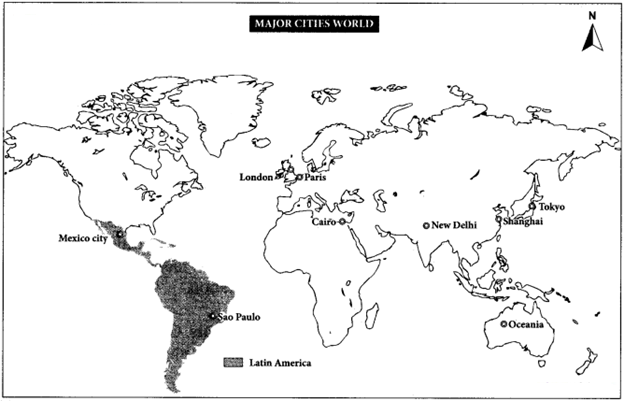8th Social Science – Geography Book Back
& Questions Answers (solution)
Term 2
1. Migration and Urbanisation
8th Social Science Term 2 Chapter 1.Migration and Urbanisation Textbook Evaluation – English Medium
I. Choose the correct answer
1. People move from …………… to …………… mainly in search of better jobs.
(a) Rural to Urban
(b) Urban to Rural
(c) Hills to plains
(d) Plains to hills
Answer: (a) Rural to Urban
2. A person moves from his own country to another country is known as ……………
(a) Immigrant
(b) Refugee
(c) Emigrant
(d) Asylum seeker
Answer: (c) Emigrant
3. The migration in search of fertile agricultural land is …………… migration.
(a) Rural to Rural
(b) Rural to Urban
(c) Urban to Rural
(d) Urban to Urban
Answer: (a) Rural to Rural
4. War is one of the …………… causes of human migration.
(a) Demographic
(b) Socio – Cultural
(c) Political
(d) Economic
Answer: (c) Political
5. The main reason for the development of urbanization in pre – historic period was ……………
(a) Production of food grains
(b) Domestication of cattle
(c) Fishing
(d) hunting
Answer: (b) Domestication of cattle
II. Fill in the Blanks
- Urbanization is determined by …………… number of factors.
- …………… is the major push factor operating in rural areas.
- …………… Metropolitan city in India has the second highest urban population in the world.
- The movement of a person based on his free will and desire to live in a better place is …………… migration.
- In modem time urban growth was accelerated by the development of ……………
Answer:
- Three
- Poverty
- Delhi
- Voluntary
- Towns and cities
III. Match the following
- Emigration – In migration
- Immigration – Out migration
- Pull factor – Employment
- Push factor – Socio – Cultural migration
- Marriage – Employment opportunity
Answer:
- Emigration – Out migration
- Immigration – In migration
- Pull factor – Socio – Cultural migration
- Push factor – Employment opportunity
- Marriage – Employment
IV. State whether the following statements are True or False
- Slums are generally found in cities.
- Mass migration is absent in the modem period.
- The process of Urbanisation has a short history.
- Cities and towns are the major polluters of environment.
- Transhumance is also referred as seasonal migration.
Answer:
- True
- True
- False
- True
- True
V. Consider the given statements and choose the correct option the given ones
Statement (A) – Urbanisation is mainly due to the movement of people from rural to cities.
Reason (R) – Rural to Urban migration is not a predominant one.
(a) A is correct but R is incorrect
(b) Both A and R are incorrect
(c) Both A and R are correct
(d) A is incorrect and R is correct
Answer: (a) A is correct but R is incorrect
VI. Answer the following questions in brief
1. Define “Migration”.
Answer:
Migration has been defined differently by different experts. In general migration is defined as the permanent or semi permanent change of residence of an individual or group of people over a significant distance. So, the term migration refers to the movement of people from one place to another.
2. What are the causes of rural to urban migration?
Answer:
- Ecological or Natural causes of migration
- Economic causes of migration
- Socio – cultural causes of migration
- Demographic causes of migration
- Political causes of migration
3. State the causes of the ecological or natural migration.
Answer:
- Natural causes include volcanic eruption, mankind changed considerably.
- At this stage, people continued to move from one region to another in search of fertile land for cultivation.
4. Name any two pull factor of migration.
Answer:
- Availability of better job opportunity.
- Fertile land
5. What is Urbanization?
Answer:
Urbanization refers to the process in which there is an increase in the proportion of population living in towns and cities.
6. List out any four most populous cities in the world.
Answer:
- Tokyo (Japan)
- Delhi (India)
- Shanghai (China)
- Mexico city (Mexico)
VII Answer the following questions in detail
1. What are the different types of migration? Explain.
Answer:
Migration can be classified in several ways. They are:
1. Based on the movement associated with administrative limits.
(a) Internal Migration
(b) International Migration
2. Based on the willingness of the migrants for migration.
(a) Voluntary Migration
(b) Involuntary Migration
3. Based on the duration of stay of migrants in the place of destination.
(a) Short term Migration
(b) Long term Migration
(c) Seasonal Migration
1. Based on the movement associated with administrative limits.
(a) Internal Migration:
- The movement of people within a country is known as internal migration.
- Further internal migration is classified into four types. They are,
- Rural to Urban migration
- Urban to Urban migration
- Rural to Rural migration and
- Urban to Rural migration
(b) International Migration:
Migration that occurs across the national boundaries are known as international migration.
2. Based on the Willingness of the migrants for migration:
(a) Voluntary migration:
- If the migration takes place on perspus free will, initiative and desire to live in a better place.
(b) Involuntary migration:
- If the migration takes place against the will of migrants is known as involuntary migration.
3. Based on the duration of stay of migrants in the place of destination:
(a) Short term migration:
- The migrants stay outside only for a short duration before returning to the place of origin.
(b) Long term migration:
- The migrants stay outside at least for a few years.
(c) Seasonal migration:
- Usually a group of people migrates from their native places during a particular season and return after end of that season.
- Transhumance is an another example of seasonal migration.
2. Explain in detail about the various causes of migration.
Answer:
1. Ecological or Natural causes of migration:
- The causes operate under this category are natural ones. They include Valcanic eruption, mankind changed considerably.
- At this stage, people continued to move from one region to another in search of fertile land for cultivation.
2. Economic causes of migration:
- Economy is one of the most important causes of human migration from one area to another.
- The availability of fertile agricultural land, employment opportunities, development of technology etc. are some of the economic causes that attract the migration.
3. Socio – cultural causes of migration:
- Socio – cultural causes also play some roles in the process of migration.
- For example, women after marriage.
4. Demographic causes of migration:
- In demographic sense, the population composition like age and sex, over population and under population are the major causes of migration.
- Over population is considered as a push factor and under population to be pull factor in the context of migration.
5. Political causes of migration:
- Various political causes like colonization, wars, Government policies etc. have always been playing important role in human migration from time to time.
3. Discuss the problems of urbanization.
Answer:
1. Housing and Slums:
- There is a lack of space for housing and a marked reduction in the quality of housing in the urban areas due to increase in population.
2. Over Crowding:
- Over – crowding leads to unhealthy environment in the urban areas.
- It also the cause of many diseases and riots.
3. Water Supply, Drainage and Sanitation:
- No city has round the clock water supply in the world.
- Drainage situation is equally bad.
- The removal of garbage is a Himalayan task for urban local bodies.
4. Transportation and Traffic:
- Absence of planned and adequate arrangements for traffic and transport is another problem in urban centers.
- The increasing number of two wheeler and cars make the traffic problem worse.
5. Pollution:
- Towns and cities are the major polluters of environment.
- Several cities discharge their entire sewage and industrial effluents untreated into the near by rivers. Industries in and around the urban centers pollute the atmosphere with smoke and toxic gases.
VIII. Map Study
1. On the outline map of the world mark the following places
- Tokyo
- New Delhi
- Mexico city
- Shanghai
- Sao Paulo
- Oceania
- Latin America
- Paris
- London
- Cairo
Answer:

IX. Activities
1. List out and analyze the reason for migration of people in your locality.
Answer:
People migrate for a number of reasons. The reasons and causes for migration would normally fall under these areas:
- Environmental – Better climate, calamities and natural disasters are examples of environmental causes or reasons.
- Economic – Moving to find work or moving to follow a particular career path is an example of economic cause or reason.
- Cultural – Religious freedom and education is an example of cultural cause or reason.
- Political – Civil war or escaping from political persecution is an example of political cause.
- Social – Moving for a better quality of life or moving closer to a family member or friend is an example of a social cause or reason.
2. Collect the pictures and information regarding the effects of urbanization and make an album.
Answer:
Activity to be done by the students.
Tags:
8th social guide samacheer kalvi,samacheer kalvi 8th books guide social science,social guide for 8th standard samacheer kalvi,samacheer kalvi guru 8th social guide,8th standard social guide samacheer kalvi,samacheer kalvi 8th social guide pdf,8th social guide tamil medium samacheer kalvi,8th social guide tamil medium samacheer kalvi,samacheer kalvi 8th books guide social science,samacheer kalvi guru 8th social guide,samacheer kalvi 8th social guide pdf,8th standard social guide samacheer kalvi,8th social guide tamil medium samacheer kalvi,8th social guide tamil medium samacheer kalvi,social guide for 8th standard samacheer kalvi,samacheer kalvi 8th books guide social science,samacheer kalvi guru 8th social guide,social guide for 8th standard samacheer kalvi,samacheer kalvi 8th social guide pdf,8th standard social guide samacheer kalvi,samacheer kalvi 8th books guide social science,samacheer kalvi guru 8th social guide,social guide for 8th standard samacheer kalvi,8th social guide tamil medium samacheer kalvi,8th standard social guide samacheer kalvi,8th social guide tamil medium samacheer kalvi,samacheer kalvi 8th social guide pdf,samacheer kalvi 8th books guide social science,social guide for 8th standard samacheer kalvi,samacheer kalvi guru 8th social guide,8th social guide tamil medium samacheer kalvi,8th standard social guide samacheer kalvi,samacheer kalvi 8th social guide pdf,8th social guide tamil medium samacheer kalvi,samacheer kalvi 8th books guide social science,social guide for 8th standard samacheer kalvi,samacheer kalvi guru 8th social guide,8th social guide tamil medium samacheer kalvi,8th social guide tamil medium samacheer kalvi,samacheer kalvi 8th social guide pdf,8th standard social guide samacheer kalvi,samacheer kalvi 8th books guide social science,samacheer kalvi guru 8th social guide,social guide for 8th standard samacheer kalvi,samacheer kalvi 8th social guide pdf,8th standard social guide samacheer kalvi,8th social guide tamil medium samacheer kalvi,samacheer kalvi 8th books guide social science,social guide for 8th standard samacheer kalvi,samacheer kalvi guru 8th social guide,8th social guide tamil medium samacheer kalvi,8th standard social guide samacheer kalvi,samacheer kalvi 8th social guide pdf,8th social guide tamil medium samacheer kalvi,


